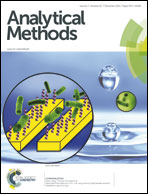Application of mixed-mode ultra high performance liquid chromatography to forensic drug analysis
Abstract
Methodology is presented for the analysis of drugs of forensic interest employing a single column and the same solutions from two solvent reservoirs at different ratios for orthogonal reversed phase chromatographic and hydrophilic interaction liquid chromatographic separations. For the determination of the basic drugs in the SAMHSA-5 panel in urine, a 2.1 × 150 mm × 2.7 μm superficially porous dimethylpentafluorophenylpropyl (PFP) column was employed using two acetonitrile–water–ammonium formate solutions as A and B solvents for a binary pump with time of flight mass spectrometric (TOF-MS) detection. Applicable to the analysis of seized drugs, the same column and detector was used with acetonitrile–water–ammonium acetate solutions as A and B solvents for the separation of 15 controlled “bath salts”. For both applications, employing mixed mode chromatography minimized ion suppression and allowed the unique identification of each analyte. Solid phase extraction (SPE) performed on a mixed mode MM1 column successfully recovered the solutes of interest with good recovery and minimum ion suppression or ion enhancement was observed for the ultra high performance liquid chromatography-TOF-MS analysis of the extracts. For the SPE sample preparation no evaporation and reconstitution step was required, with the elution solvent directly compatible with both the HILIC and RPC analysis on the same stationary phase.


 Please wait while we load your content...
Please wait while we load your content...